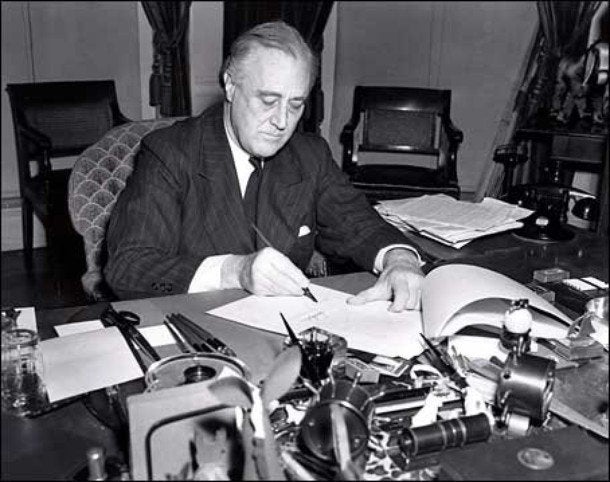(Disclaimer: The opinions expressed in this column of those of the author and do not necessarily reflect those of The Augusta Press.)
A few days ago, a friend alerted me that the U.S. Senate had passed a “Ukraine Lend-Lease” bill – and unanimously, at that. The House was expected to follow suit, and it did, with only 10 no votes (my own Congressman, Rick Allen, did not vote).
I can’t begin to tell you the personal impact this made.
You see, in 1981, I abandoned my law practice and returned to graduate school to earn a Ph.D. in history. The biggest thing you do in graduate school is choose your dissertation topic, because you will live with it until you graduate, and beyond. My topic? The impact of Lend-Lease aid on the Soviet war effort in World War II. My wife accused me of spending my time counting boots (we sent 12 million pair), but there was more to it than that. Three years after graduating in 1986, a modified version of the dissertation came out as my first book, FEEDING THE BEAR.
World War II Lend-Lease was a vast program. In today’s money, it cost $734 billion. But its impact went beyond its value. Lend-Lease enabled Britain to continue its lonely struggle against Hitler. In the case of aid to the Soviet Union, Lend-Lease included many specialized materials and chemicals that the Soviets either could not, or had lost the capacity, to manufacture.
MORE: COLUMN: Perry Smith suggests books to help understand events in Ukraine
Using Lend-Lease in the new bill is highly symbolic. The establishment of Lend-Lease in March of 1941, nine months before Pearl Harbor, was a huge step for a neutral America. Then and now, it was intended as means of opposing aggression without going to war. There are, however, some major differences. The current bill specifically mentions Ukraine; the 1941 version did not, allowing the president to designate countries that were victims of aggression. In theory, this prevents the current president from sending aid to whomever he chooses, although in practice, this makes little difference.
A more important difference is that the original Lend-Lease bill could not end until the Third Reich was destroyed. Russia need not be destroyed for this crisis to end. Finally, Lend-Lease was passed in March 1941 because Hitler was doing extremely well. Under KGB Colonel Putin, Russia has suffered its worst military performance since the Crimean War (1853-56), and his strategy is the worst since Joseph Stalin’s in the period before Hitler invaded the Soviet Union. Shock and awe, as exemplified by his initial advance on Kyiv, is great, but you’d better have a plan B. The only thing that Putin has achieved so far is to create some bipartisanship in the United States.
What does Lend-Lease mean for America? Sending weapons to one side in a conflict is not precisely consonant with “neutrality,” but it does equal participation in a war either. International law scholars settled on the term, “nonbelligerent” to describe a country in this situation. Does this mean escalation? Not necessarily. It did not, in World War II. Lend-Lease was part of President Franklin D. Roosevelt’s strategy of preventing the spread of war toward us by shoring up Britain. The other half of this strategy was moving the Pacific Fleet to Hawaii, hoping to deter Japanese aggression. (Didn’t work.) But every month that war could be delayed meant that we would be readier. Preventing Hitler from winning a total victory by aiding his two primary opponents (Britain and later the Soviet Union) was key to improving our readiness. But it did not cause Nazi Germany to go to war against us. That happened because of Pearl Harbor, as Nazi Germany declared war on the United States because of its alliance with Japan.
What is the strategy behind the U.S. government’s indirect support of Ukraine? There are two things that explain it.
First, the United States and its allies had made clear that an attempt to overrun Ukraine would be unacceptable and that we would take countermeasures. Once the invasion began, we had the choice of a humiliating back down, or taking steps to punish the invaders. Second, the Biden administration and its allies are engaging in a strategy of “forward defense,” because assisting Ukraine protects threats to our easternmost NATO allies – countries that are militarily weak and whose defense would require direct American military intervention.
So where will this end?
Lend-Lease aid will certainly help slow down the invasion. American weaponry is superior to that shown by Russia so far. It must be galling for some Russians that their tank forces have been so vulnerable and ineffective; this was a country, after all, that developed World War II’s finest tank designs. Unfortunately for Russian soldiers, their leaders pursued wholly ineffective tank programs and, as always, it is the common soldier who pays the price for the leaders’ incompetence. The situation is different from World War II, when the weaponry we sent was not always superior; Stalin even wrote Roosevelt asking him not to send any more of our tanks.
But no matter how good our assistance, Russia has the initiative. As the bigger country, it can continue to send military forces and wear Ukraine down. Also, Russia may escalate to chemical, biological or even nuclear weapons to break the military deadlock. Even if the fighting is halted, the postwar situation is going to be extremely difficult, with Ukraine undoubtedly petitioning for NATO membership, a request that will not be well received by Western governments.
The proverbial bottom line: Lend-Lease will help, and at the very least, buy time for Ukraine. In the long run, however, we will have to find Putin a face-saving exit from this war, and it will have to be a better choice than either eternal war in Ukraine or World War III.
Hubert van Tuyll is an occasional contributor of news analysis for The Augusta Press. Reach him at hvantuyl@augusta.edu








